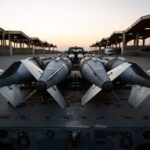How a 20 kW Laser Could Stop North Korean Drones in Their Tracks—Future of Air Defense
Daniel Kim Views

In December, a new air defense system will be deployed at the Building GOP, tasked with protecting the skies over Seoul. This system, known as the Block-I Laser Air Defense Weapon, is an early response to North Korea’s recent provocations, including small drones that entered Seoul’s airspace in 2022 and recent incidents involving propaganda balloons.
According to military sources, as of the 11th, a 20-kilowatt (kW) class Block-I Laser Air Defense Weapon will be installed at the Building GOP in Seoul by the end of this year. This system is designed to intercept and shoot down small drones and unmanned aerial vehicles with precision from several kilometers away, leveraging the speed of light for its laser attacks.
The Block-I laser system is noted for its low operational cost and high efficiency. Each shot costs approximately 2,000 won ($1.70) and can be operated anywhere there is a power source.
A military official stated, “Block-I has undergone rigorous testing and evaluation, achieving a 100% hit rate by successfully targeting all 30 drones at a distance of 3 kilometers after 30 shots.” The official added, “We plan to deploy this system at the Building GOP to enhance air defense over Seoul within the year.”
Previously, when North Korean drones entered South Korean airspace, the standard response involved 20mm Vulcan and 30mm wheeled anti-aircraft guns. Surface-to-air guided missiles like the ‘Shingung’ and ‘Cheongung’ were used for medium-sized drones. However, responding to small drones, which generally fly at altitudes of 2 to 3 kilometers and speeds of about 100 kilometers per hour, with these expensive and less efficient systems has been deemed less cost-effective and operationally challenging.
The Block-I Laser Air Defense Weapon represents a significant improvement. It uses a laser generated from an optical fiber to directly target and neutralize threats, making it a key component in effectively addressing these challenges.

The Ministry of National Defense has allocated an additional 1.5 billion won ($1.3 million) to the defense budget this year to cover the mass production costs of the new laser air defense system, which is set to be deployed by the end of the year.
The Block-I Laser Air Defense Weapon has demonstrated impressive performance during testing, achieving a 100% hit rate by successfully targeting all drones at a distance of approximately 3 kilometers. In April last year, the Defense Acquisition Program Administration reported that the Agency for Defense Development (ADD) conducted a test evaluation at the Anheung Test Site in Taean, Chungnam. The laser system received a “combat suitability judgment” from the Ministry of National Defense after hitting all 30 drones during the 30-shot test.
The deployment of such air defense technology marks a significant advancement from cinematic depictions like those in Star Wars. The domestic laser air defense system, often called the “Korean version of Iron Beam,” has moved from science fiction to practical application.
This laser cannon can be installed in fixed positions, such as at the front lines, to shoot down enemy drones from several kilometers away. It operates with a simple electricity supply, eliminating the need for traditional ammunition and reducing the risk of safety accidents associated with falling bullets from missiles and machine guns. Additionally, the cost per shot is meager, at around 2,000 won ($1.70), and the system operates silently, offering both economic and operational advantages.

The Ministry of National Defense is prioritizing the development of laser weapons for drone interception for several vital reasons.
Firstly, existing anti-aircraft guns have notable limitations. The 20mm and 30mm anti-aircraft systems currently in use in Korea are equipped with self-destruct fuses, but they still have a failure rate of 2-3%. This means a number of projectiles could fall to the ground, posing risks to civilian areas.
For instance, during the Iraq War, the U.S. employed the Centurion C-RAM, a ground-based variant of the 20mm Vulcan gun. While it performed well, it also led to significant issues when spent rounds and fragments damaged nearby homes.
In Korea, the effective range of the 30mm anti-aircraft guns deployed in metropolitan areas is about 3 kilometers. However, these guns can fire projectiles up to 10 kilometers, potentially reaching not just civilian areas but also crossing into North Korean territory. This presents a substantial risk and burden. In contrast, laser air defense weapons have an impressive accuracy rate of over 99% if the target is detected. They also avoid secondary damage since they don’t have physical projectiles. Additionally, the cost per shot is between 1,000 and 2,000 won, making them an economically viable option for the military.
Laser air defense weapons offer several advantages:
- High Accuracy: Lasers travel 300,000 kilometers per second, making them capable of intercepting even hypersonic missiles at Mach 8.0. They can precisely target and destroy objects smaller than a 5.56mm bullet.
- Cost-Effectiveness: Each shot costs around 2,000 won, significantly cheaper than other systems like the Shingung portable anti-aircraft missile, which costs 200 million won per shot, and the PAC-3 missile, which costs 8 billion won per shot.
- Operational Efficiency: Laser systems require only an electricity supply and no separate ammunition, reducing logistical burdens and the risk of ground damage from spent shells compared to traditional guns and missiles.

While laser weapons offer significant advantages, they also have several limitations.
One major drawback is that lasers can be scattered or refracted by environmental conditions such as fog or rain, reducing their effectiveness in projecting energy onto a target. Additionally, lasers require a clear line of sight to engage with a target. Obstacles like mountains or specific materials can block the laser’s path, significantly diminishing its attack power. Continuous tracking and energy application are required for fast-moving targets. Quick maneuvers by the target can make monitoring and engagement challenging, increasing the likelihood of failure.
The effectiveness of a laser weapon is primarily determined by its output. Higher output levels allow for a broader range of target engagement. Currently, laser systems operate at an output of 20 to 60 kilowatts (kW), sufficient for intercepting drones. However, to impact larger targets effectively, higher output is needed. For example, a 100 kW output is required to destroy an anti-tank missile, 300 kW for a cruise missile, and a megawatt (MW) output is necessary for fighter jets or significant ground targets—generally, the greater the output, the more influential the weapon.
Increasing the output of laser systems requires a larger and more complex system, a challenge that current technology struggles to address. The Defense Acquisition Program Administration (DAPA) plans to boost the output of the Block-I laser air defense weapon from 20 kW to 30 kW by 2030. Additionally, DAPA aims to develop a Block-II version that can be mounted on aircraft, ships, or vehicles. If successful, this advancement will enhance the system’s capability to target not only the 1.8-meter drones that have previously violated South Korea’s airspace but also much smaller drones.
A military source noted, “We are concentrating our efforts on securing the budget for mass production and deployment of laser air defense weapons to ensure their operational readiness as soon as possible.”















Most Commented